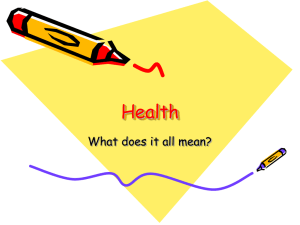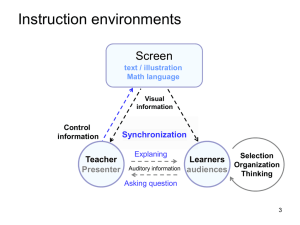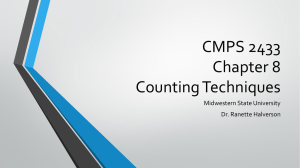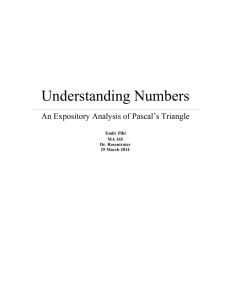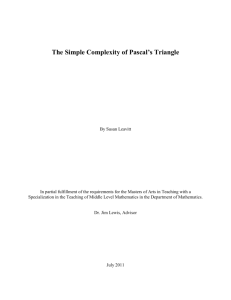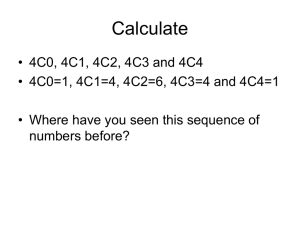Pascal`s Triangle
advertisement
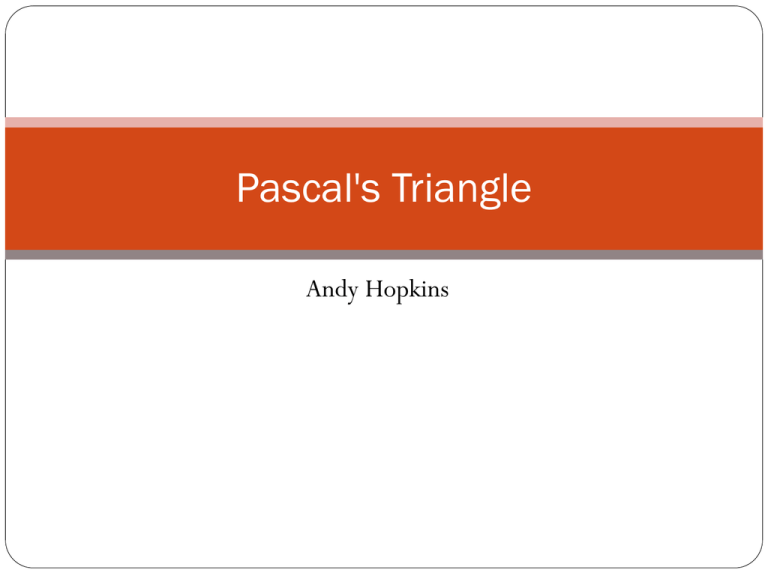
Pascal's Triangle Andy Hopkins A Brief History… Pascal was not the first to have discovered this triangle. Al-Karaji knew of the triangle during his lifetime(953-1029). Also was discussed by Omar Khayyam. (It is known as Khayyam’s triangle in Iran) Yang Hui discovered this triangle in China during his lifetime(1238-1298). (Known as Yang Hui’s triangle in China). Known as Tartaglia’s triangle in Italy (Tartaglia lived from 1500-1577). Pascal published his work in 1655. http://en.wikipedia.org/wiki/Pascal_triangle# History http://milan.milanovic.org/math/english/fibo /fibo0.html Pascal’s work Blaise Pascal published his paper with the help of Pierre de Fermat. In the paper he explained everything that he had discovered about the triangle. It starts with how to construct the triangle and then went on to list the 19 corollaries he found. http://milan.milanovic.org/math/english/fibo /fibo0.html Smith, David E. A Source Book in Mathematics. First ed. New York: McGraw-Hill Book Company, Inc., 1929. How Pascal Starts the Triangle What Pascal did was took a point (which he called G) and drew a line to the right of it and down from it. Then he drew lines from one line to the other to create 10 different triangles. He then proceeded to draw lines parallel to each line that was constructed from point G to create cells. After this he started with a number that he calls the generator. This, of course, is the number one. However, it can be a different number than one if you want to construct a different triangle. The final thing that he states is that you can find the other cells based on this rule: The numbers of each cell are equal to the sum of the previous cells to the left and above the cell you are trying to find. Smith, David E. A Source Book in Mathematics. First ed. New York: McGraw-Hill Book Company, Inc., 1929. Pascal’s Corollaries To do all of Pascal’s corollaries in a paper or a presentation would take a lot of time. I decided to do them on corollaries 1-3, 5-9, and 11. The first one just states that the number one is in each cell of the first row and column. The next two are similar in saying that if you take consecutive numbers in a row or column and add them up your result will be in the next row or column. We call this the Hockey Stick pattern. Smith, David E. A Source Book in Mathematics. First ed. New York: McGraw-Hill Book Company, Inc., 1929. http://ptri1.tripod.com/ Corollaries con’t There are also corollaries that use previous corollaries to help solve the current one. Corollary 7 says that the sum of a row divided by 2 is equal to the sum of the previous row. Corollary 8 says that the sum of each row is a number in the geometric progression (1,2,4,8,16,32…). This is true if we add up the numbers in each row and divide by 2 (corollary 7). Smith, David E. A Source Book in Mathematics. First ed. New York: McGraw-Hill Book Company, Inc., 1929. Examples of previous triangles. This is a pre-Pascal triangle in Japanese http://cas.umkc.edu/math/ExtraCap tion.htm This is a pre-Pascal Chinese triangle. http://milan.milanovic.org/math/english/fib o/fibo0.html This was published in a 1407 editon of Jordanus' de Arithmetica. http://milan.milanovic.org/math/english/fibo/fibo0.html This was published in 1544 by Michael Stifel of Germany http://milan.milanovic.org/mat h/english/fibo/fibo0.html This table was published in 1636 by Father Marin Mersenne. http://milan.milanovic.org/mat h/english/fibo/fibo0.html This is Pascal’s original triangle. http://threesixty36 0.wordpress.com/2 007/11/


